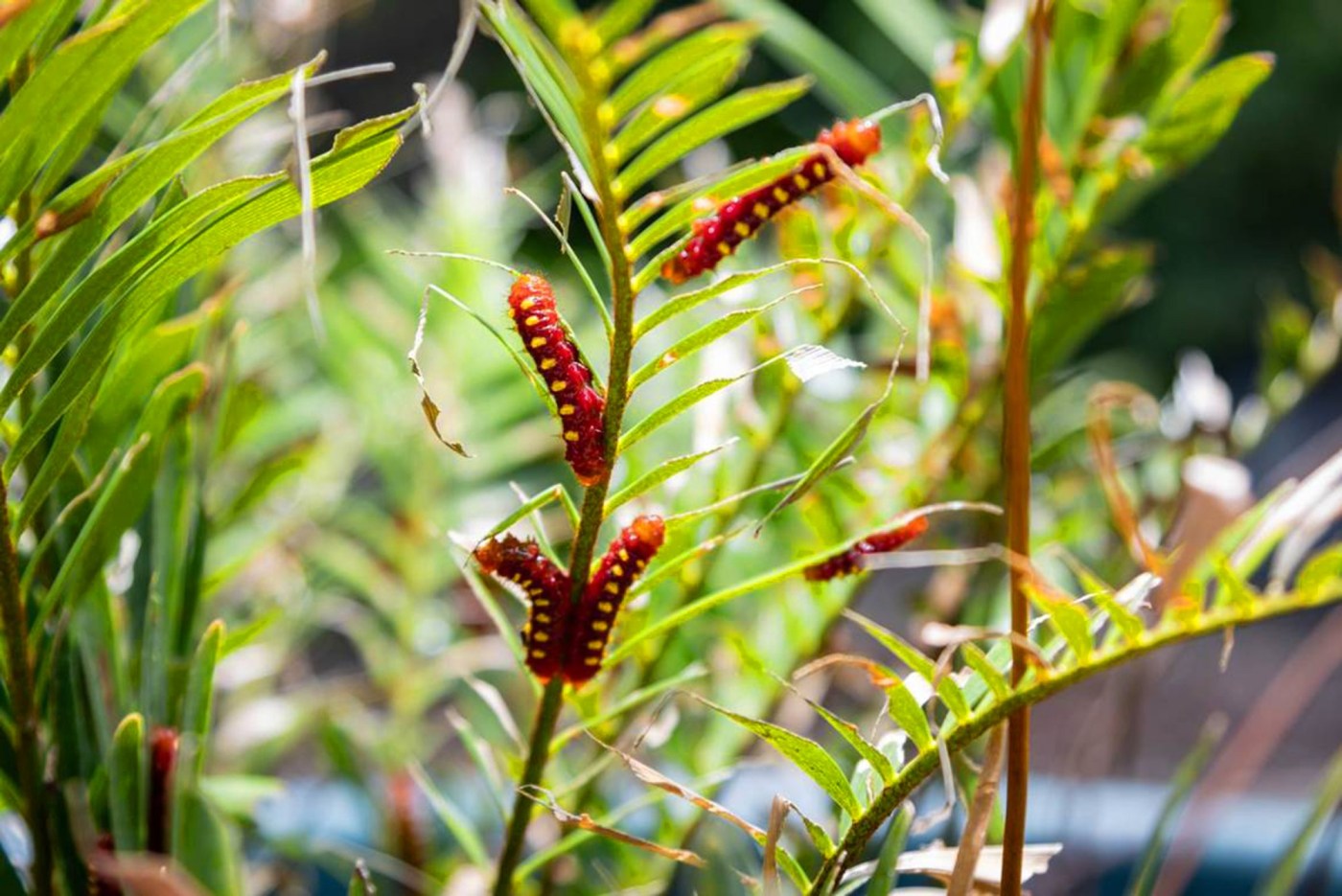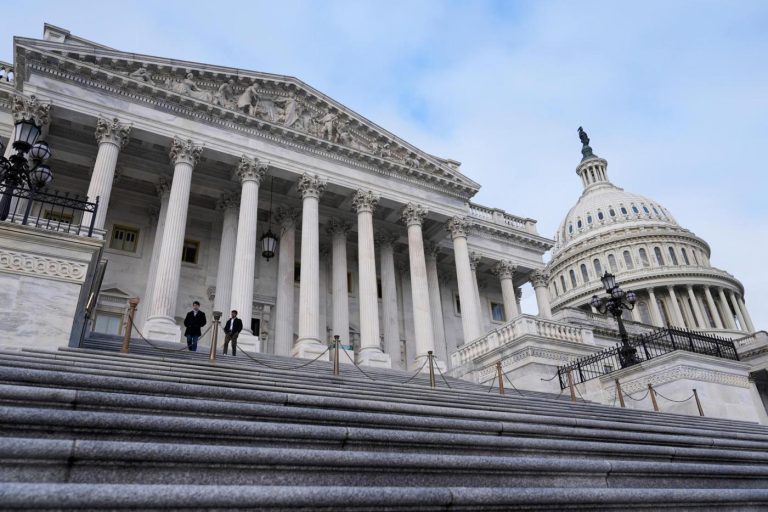Ashley Miznazi | (TNS) Miami Herald
MIAMI — A small butterfly once thought extinct has staged such a comeback in South Florida that it is now considered a bit of a garden pest — and a persistent problem for a renowned research facility where its caterpillars feast on a curated collection of tropical plants, some of them rarer than the insect munching them.
The butterfly is the atala, a South Florida native whose life cycle and survival has long been tied to a unique “host plant” called the coontie. Atala lay eggs in the thick fernlike foliage, which then provides food to emerging voracious caterpillars that will metamorphose into jet-black butterflies with bright red bodies and an iridescent teal shimmer in their wings.
The coontie, sometimes sold as the “coontie palm,” is actually what’s known as a cycad — and its the only native North American member of a family of plants often called living fossils because many species remain unchanged from the dinosaur age.
But it turns out that the atala, which experts still consider imperiled despite the rebound, has an appetite for more than just coontie. And that’s a growing concern for the managers of Montgomery Botanical Center, a lush 120-acre site concealed behind gates off Old Cutler Road that is home to one of the nation’s oldest and most diverse collections of cycads.
Vince Ramirez, Montgomery’s curator of cycads, said the atala caterpillars have caused “mass destruction” this year, skeletonizing genetically similar species. The infestation is serious enough that he’s hosting scheduled tours this summer for butterfly enthusiasts to pluck caterpillars and transplant them to their own gardens. The goal is strike a balance between protecting the plants and preserving the butterfly.
“The bottom line is it’s a dilemma because we love the plant and we love the butterfly,” said Patrick Griffith, the executive director of Montgomery Botanical Center. “It’s a rare butterfly found in small numbers. But the healthier the butterfly, the worse it is for the cycads.”
The curious atala comeback
South Florida is home to many imperiled butterflies, many victims of the habitat loss — like the destruction of Miami-Dade’s pine rockland forests, which have been largely plowed under for suburban development.
But the atala’s comeback story has a few unusual twists. Development, for instance, is only part of the reason why the once abundant atala vanished nearly a half century ago. The coontie — the only cycad native to the United States — was also prized by people. Its roots were once ground up and used by indigenous tribes as a flour (please don’t try this, experts say, as the roots are toxic enough to kill you if prepared wrong). So when white settlers began coming to Miami at the turn of the 20th century, they harvested the wild-growing plant as a crop, even opening coontie mills in places like Arch Creek.
The overproduction of the region’s first cash crop nearly eradicated it. Bulldozers over the next decades continued the job, reducing the coontie to isolated wild stands. And as the host plant vanished, so did the atala. By the time the U.S. Endangered Species Act passed in 1973, the atala was already thought to be extinct and wasn’t even listed.
That is until Roger Hammer, a naturalist from South Miami-Dade who would go on to write a string of books on native plants and butterflies, was searching Virginia Key in 1979 for a rare tree, the Biscayne prickly ash, and was stopped in his tracks by some small brightly colored caterpillars eating the coontie palm.
“I thought what the hell is eating coontie, you know, something so poisonous,” said Hammer, who was a long-time senior naturalist for the Miami-Dade County Parks Department. “When they hatched I knew exactly what they were.”
At this point, the atala butterflies were thought to be extinct for around 15 years. Over the years, Hammer quietly transplanted caterpillars to parks in Miami-Dade and Broward. He told the Herald he also let a handful of caterpillars go at Montgomery back in the early 1980s.
As word got around, the community of butterfly enthusiasts in South Florida also came to the rescue. The coontie, a hardy low-maintenance plant, started showing up in yard landscaping and gardens. And since the butterfly was never listed as federally endangered, it made it easier for the butterfly hobbyists and scientists to take repopulating the colony into their own hands, said Dennis Olle, the president of the Miami Blue Chapter of the North American Butterfly Association.
The National Butterfly Association door-knocked on houses with caterpillars when they saw coontie on porches or in yards and asked homeowners to place caterpillars on their plants. Not everyone was keen to having a small, wriggly, alien-looking insect eat up their coontie, but the plants rebounded.
While the population of atala has dramatically expanded over the decades, experts consider the butterfly at risk — in large part because its population is confined to Southeast Florida. Atala also can be found in Cuba, the Bahamas and on some Caribbean islands.
Sandy Koi, a post-doctorate scientist from Florida International University who studied insect ecology and conservation and is also called the guru of the atala, said with the demise of coontie in the wild, gardens and yards now make up about 50 percent of their food source. Koi also got a grant in 2004 to distribute thousands of atala in the Everglades in an effort to further expand and protect the populations.
At the start, researchers were sticklers about not introducing the butterfly to areas it wasn’t originally found in the region. But then the preservation thought changed. If another hurricane were to happen, like Andrew, the entire population would be knocked out again, Koi said. Finding coontie in the wild again was a key to long-term survival.
“The butterfly is confined to eating what little is left of it,” Koi said. “If it weren’t for the gardens, the butterflies would have nowhere to go.”
Saving the cycads
At Montgomery, the atala success story poses a different preservation challenge. The thousands of cycads planted there can’t be replaced with a trip to Lowes or the neighborhood nursery.
Seeds for Montgomery’s plants have been collected in over 50 expeditions to different countries. The mission at the center is to help maintain global genetic diversity, so many of the cycads in their collection are rare.
Some cycads may look like palms but they differ dramatically. They typically grow far more slowly and reproduction can also be a slow process. Cycads produce what are called “pollinator cones,” not unlike a pine cone. But because they’re also what botanists call “dioecious,” meaning there are male seed cones and female seeds, it takes two to tango. In nature, the process is often aided by certain beetles or even the wind but at Montgomery, staff often hand fertilize seeds and keep them in a fridge until ready to plant — like a sperm, or seed, bank.
A warming climate also could impact cycads — but, in an unusual effect, perhaps for the better. After the European heat waves, one botanical garden in the United Kingdom produced male and female cones for the first time in 60 million years.
Executive director, Griffith, said the caterpillars can threaten the long-term conservation of some cycad species and controlling them has eaten up a lot of time and labor as well over the last few years.
Montgomery has tried a lot of things. They’ve applied soapy water to discourage egg-laying and erected anti-butterfly cages around some newly planted cycads. They’ve also tapped outsiders, from researchers to home butterfly gardeners and grade schoolers, to collect caterpillars and keep them in check.
Zoo Miami is also a major partner, doing rescue missions to Montgomery that have collected more than 4,000 atala caterpillars and pupae this year, and nearly 6,000 in both 2022 and 2023. Caterpillars are put directly on coontie the zoo planted near the pine rockland forest, and chrysalises are brought into what the zoo calls a “butterfly bunker” which was originally used to hold weapons in World War II.
The chrysalids stay inside of the bunker in pop-up mesh butterfly cages until they hatch and are ready to be released at the zoo. They also do giveaways of chrysalises ready to hatch into butterflies for Fairchild Tropical Botanical Garden members in the citizen science program who agree to keep a garden of native plants to attract pollinators with no pesticides.
Koi said in the long-term, the best home to preserve an atala population is by relying on native coontie. Cycads are poisonous plants, and different varieties could hold different levels of toxins. If the caterpillars pick the wrong poison, she’s seen them die.
How to attract atala to your garden
If you want to attract atala yourself, the best first step is to find a nursery that sells coontie and plant some. While the butterflies, which can live for months, are pretty, what they do to the plants isn’t. But the devoured plants typically rebound to host more butterflies.
“If you don’t have those plants you don’t have a breeding population,” Hammer said. “Some people just think of them as pests. They don’t want the caterpillars but they want the butterflies as adults.”
Zoo Miami also has a guide with native plants to attract butterflies, like nectar sources like the beauty berry and buttonbush, and the University of Florida compiled a list of Homestead farms that sell native plants.
If you don’t know where to start, the Institute for Regional Conservation has a tool called natives for your neighborhood where you can type in your zip code and it’ll show you what used to grow there.
“The best thing you can do is plant coontie, make the most beautiful garden you can and the atala will come,” Hammer said.
____
Ashley Miznazi is a climate change reporter for the Miami Herald funded by the Lynn and Louis Wolfson II Family Foundation in partnership with Journalism Funding Partners.
©2024 Miami Herald. Visit at miamiherald.com. Distributed by Tribune Content Agency, LLC.












